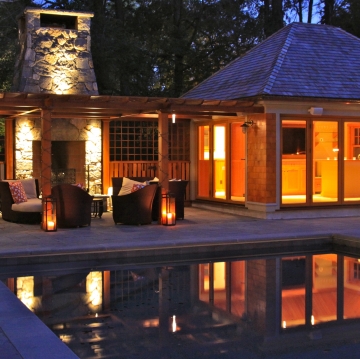Landscape Now: 5 Tips For Landscape Lighting

Homeowners spend a considerable amount of effort, time, and expense creating their landscape gardens, patios, walks, features, and plantings, yet many times there is little thought about landscape lighting to highlight and illuminate their landscape for viewing and use when the sun goes down.
With a well-designed lighting plan, your landscape can become enjoyable during the evening hours…in spring, summer, fall and even during the winter months from inside your home. With appropriately placed light sources you can achieve moonlight effects, highlights for focal points, illumination of paths and patios for safety and balanced lighting to tie in the landscape plantings, structures and lighting creating a very aesthetically pleasing landscape design. Let’s look at 5 tips to consider when designing landscape lighting and mistakes to avoid!
The Design Comes First
As with any project involving your landscape, gardens, and construction projects, it is extremely important to create a plan and design for the placement of light sources in your landscape, identify the principles of light to be used, techniques to be implemented, bulbs, fixtures, transformers, and wire needed. Although homeowners can investigate lighting and learn the basic principles, it is advised to seek out a landscape lighting designer to consult with to plan and implement major projects. Their expertise and familiarity with the intricate nature of low voltage lighting, effect of light and the numerous ways to provide the appropriate amount and intensity of light.
Goals of Landscape Lighting
The major goals of lighting are to provide security, ensure safety in the landscape, appropriate lighting for various needs and the overall aesthetics of the lighting plan. Each goal can be achieved in numerous ways, with each technique and choices affecting the overall aesthetic result of the lighting design. Although fixtures are the vehicles that hold the bulb, it is the light source (bulb) that is the most critical decision to be made by the designer.
Landscape Lighting Design Principles
Five principles of lighting design are:
- Cohesion: the lighting plan must make visual sense to the viewer, combining the architectural, landscape, and lighting techniques into a sensible relationship with each other.
- Depth: illumination of close and distance features will add depth to the owner’s view of the landscape, adding elements of intrigue to explore and move around the landscape.
- Focal points: distinctive features in a landscape deserve to be highlighted…statues, pools, specimen trees, and architectural structures like arbors, gazebos, and specialty fencing.
- Balance: There needs to be a sense of balance and proportion to the plants, structures, and features that are illuminated to create a feeling of visual congruity…areas of lighting and shadows that seem even and not unbalanced.
- Visual comfort: Nothing is more uncomfortable for the viewer than glaring light sources, extremely bright bulbs, or misplaced fixtures. Making sure the lighting sources are comfortable for the viewer will ensure there are no distractions that will impact the effectiveness of the illumination.
Light Up Your Night!
Although creating a landscape lighting design plan and project may seem involved the result of installing lighting on your property will provide numerous opportunities to enjoy your landscape year round, ensure safety for your family and visitors and add an element of security to your home!
In my next article I will discuss the allure of water gardens in your landscape and 7 key points to consider when planning to add one to your landscape!
“Light always follows the path of the beautiful.”
Read the entire article at GoLocalProv | Real Estate | Landscape Now: 5 Tips For Landscape Lighting.
